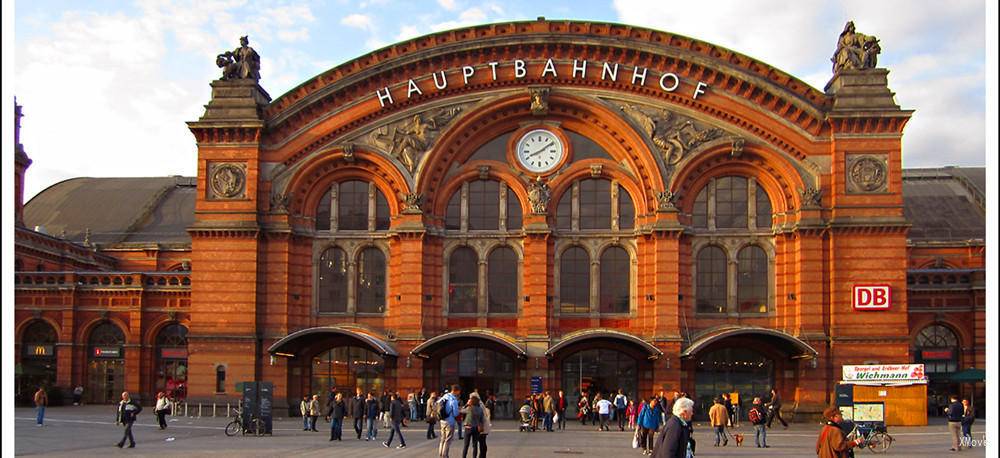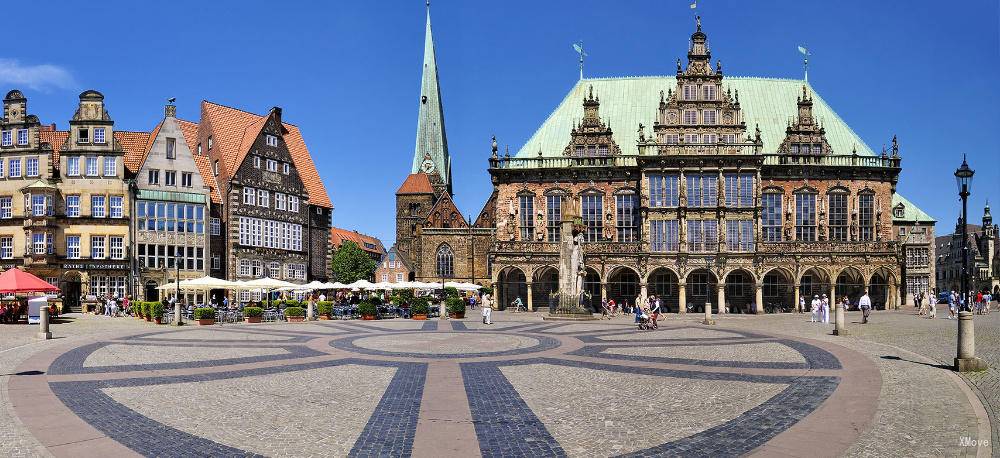Bremen Central to Aarhus: Trains, Buses, Fares, Today's Connections, Routes, Duration, Types of Trains, Station Guides, Tips, Journey
Germany Train Tickets
Scan QR code, download G2Rail App to see Bremen Central's more live update, station guide, plan and photos



Train schedule Bremen Central(Bremen Hbf) to Aarhus
Popular train routes departing from Bremen Central(Bremen Hbf)
* Idstein(Taunus)
* Delmenhorst
* Bressanone Brixen
* Kiel Central(Kiel Hbf)
* Berlin Central Station(Berlin Hbf)
* Enschede
* Bad Fallingbostel
Popular train routes arriving in Bremen Central(Bremen Hbf)
* Osnabrueck Hbf(Osnabrück Hbf)
* Wroclaw Central Station(Wroclaw Glowny)
* Marburg Sued(Marburg Süd)
* Zürich
* Strasbourg
* Wuppertal Central(Wuppertal Hbf)
* Hamburg Central(Hamburg Hbf)
Popular train routes departing from Aarhus
* Frankfurt Central(Frankfurt(Main)Hbf)
* Utrecht Centraal
* Köbenhavn H
* Muenchen Hbf(München Hbf)
* Frederikshavn St
* Copenhagen(Koebenhavn)
* Aarhus
Popular train routes arriving in Aarhus
* Wroclaw Central Station(Wroclaw Glowny)
* Paris North(Paris Gare Du Nord)
* Hildesheim Central(Hildesheim Hbf)
* Muenster Westf Hbf(Münster(Westf)Hbf)
* Rendsburg
* Zürich Hb
* Gronau(Westf)

Bremen Central
The current Bremen Central Railway Station was built between 1885-1889 and currently has about 120,000 passengers per day. It is the 12th largest railway station in Germany and the main train hub in northwestern Germany. The railway lines to the districts of Lour, Hanover, Oldenburg, Hamburg, Bremerhaven and Bremerhaven are connected at Bremen Central Station.
There are three long-distance railway lines passing through Bremen Central Station: * Bremen-Munich Line (ICE Intercity Express) * Hamburg-Cologne Line (IC Intercity Railway) * Oldenburg-Leipzig Line (IC Intercity Railway)
Bremen The Central Railway Station is a historicist building. There are four reliefs on the front of the train station that symbolize industry, trade, railway and shipping. In addition, Cologne, Hanover, Hamburg, three cities connected to Bremen and the city emblem of Bremen itself can be found on the outer wall. The roof of the train station is a copper roof. Over time, the copper top will first become gray due to chemical reactions and then turn green. The mosaic mural reflecting the tobacco growing and trade on the walls of the waiting hall is actually an advertisement produced by Martin Brinkmann, an old cigarette factory in Bremen, in 1951.
Bremen Central - Station Guide | Departures and Arrivals | Popular Routes
The City Municipality of Bremen (, also US: ; German: Stadtgemeinde Bremen, IPA: [ˈʃtatɡəˌmaɪndə ˈbʁeːmən] ; Low German also: Breem or Bräm) is the capital of the German federal state Free Hanseatic City of Bremen (also called just "Bremen" for short), a two-city-state consisting of the cities of Bremen and Bremerhaven. With around 570,000 inhabitants, the Hanseatic city is the 11th largest city of Germany as well as the second largest city of Northern Germany after Hamburg. Bremen is the largest city on the River Weser, the longest river flowing entirely in Germany, lying some 60 km (37 mi) upstream from its mouth into the North Sea, and is surrounded by the state of Lower Saxony. A commercial and industrial city, Bremen is, together with Oldenburg and Bremerhaven, part of the Bremen/Oldenburg Metropolitan Region, with 2.5 million people. Bremen is contiguous with the Lower Saxon towns of Delmenhorst, Stuhr, Achim, Weyhe, Schwanewede and Lilienthal. There is an exclave of Bremen in Bremerhaven, the "Citybremian Overseas Port Area Bremerhaven" (Stadtbremisches Überseehafengebiet Bremerhaven). Bremen is the fourth largest city in the Low German dialect area after Hamburg, Dortmund and Essen. Bremen's port, together with the port of Bremerhaven at the mouth of the Weser, is the second largest port in Germany after the Port of Hamburg. The airport of Bremen (Flughafen Bremen "Hans Koschnick") lies in the southern borough of Neustadt-Neuenland and is Germany's 12th busiest airport. Bremen is a major cultural and economic hub of Northern Germany. The city is home to dozens of historical galleries and museums, ranging from historical sculptures to major art museums, such as the Bremen Overseas Museum (Übersee-Museum Bremen). The Bremen City Hall and the Bremen Roland are UNESCO World Heritage Sites. Bremen is well known through the Brothers Grimm's fairy tale "Town Musicians of Bremen" (Die Bremer Stadtmusikanten), and there is a statue dedicated to it in front of the city hall. Bremen has a reputation as a working-class city. The city is home to many multinational companies and manufacturing centers. Companies headquartered in Bremen include the Hachez chocolate company and Vector Foiltec. Bremen's best known football club is Bundesliga club SV Werder Bremen, who play in the Weser Stadium (Weserstadion), that sits directly on the bank of the Weser.
Bremen - Guide, Attractions, Tours, Sightseeings | Train from/to Bremen | Popular RoutesAarhus (, also US: , Danish: [ˈɒːhuːˀs] ; officially spelled Århus from 1948 until 1 January 2011) is the second-largest city in Denmark and the seat of Aarhus municipality. It is located on the east coast of the Jutland peninsula, in the geographical centre of Denmark, 187 kilometres (116 mi) northwest of Copenhagen and 289 kilometres (180 mi) north of Hamburg, Germany. The inner urban area contains 273,077 inhabitants (as of 1 January 2018) and the municipal population is 340,421 (as of 2018). Aarhus is the central city in Business Region Aarhus and in the East Jutland metropolitan area, which had a total population of 1.378 million in 2016.The history of Aarhus began as a fortified Viking settlement founded in the 8th century and with the first written records stemming from the bishopric seated here from at least 948. The city was founded on the northern shores of a fjord at a natural harbour and the primary driver of growth was for centuries seaborne trade in agricultural products. Market town privileges were granted in 1441, but growth stagnated in the 17th century as the city suffered blockades and bombardments during the Swedish Wars. In the 19th century it was occupied twice by German troops during the Schleswig Wars but avoided destruction. As the industrial revolution took hold, the city grew to become the second-largest in the country by the 20th century. Today, Aarhus is at the cultural and economic core of the region and the largest centre for trade, services and industry in Jutland. The city ranks as the 92nd largest city in the European Union, and as number 234 among world cities. It is also a top 100 conference city in the world. Aarhus is the principal industrial port of the country in terms of container handling and an important trade hub in Kattegat. Major Danish companies have based their headquarters here and people commute for work and leisure from a wide area in Region Midtjylland. It is a centre for research and education in the Nordic countries and home to Aarhus University, Scandinavia's largest university, including Aarhus University Hospital and INCUBA Science Park. Being the Danish city with the youngest demographics, with 48,482 inhabitants aged under 18, Aarhus is also the second fastest growing Danish city, with an average growth of 4,500 people per annum since 2008.Aarhus is known for its musical history. In the 1950s, many jazz clubs sprang up around the city, fuelled by the young population. By the 1960s, the music scene diversified into rock and other genres. In the 1970s and 1980s, Aarhus became the centre for Denmark's rock music, fostering many iconic bands such as Kliché, TV-2 and Gnags. Aarhus is home to the annual eight-day Aarhus Jazz Festival, the SPoT Festival, and the NorthSide Festival. In 2017, Aarhus was European Capital of Culture along with Paphos in Cyprus.
Aarhus - Guide, Attractions, Tours, Sightseeings | Train from/to Aarhus | Popular Routes
Germany Train Tickets
Scan QR code, download G2Rail App to see Bremen Central's more live update, station guide, plan and photos



Hot Journeys
* Lucerne(Luzern) -> Interlaken
* Manarola -> La Spezia(La Spezia)
* Naples -> Rome(Roma)
* Frankfurt -> Cologne(Köln)
* Dusseldorf(Düsseldorf) -> Munich(Müchen)
* Florence -> Milan
* Seoul(서울) -> Busan(부산)
* Bratislava(Bratislava) -> Warsaw(Warszawa)
* Naples -> Florence
* Interlaken -> Swiss Alps Jungfrau Aletsch
* Rome(Roma) -> Milan
* Brig -> Andermatt
* Prato(Prato) -> Florence
* Beijing(北京) -> Shanghai(上海)
* Paris -> Venice(Venezia)
* Munich(Müchen) -> Dusseldorf(Düsseldorf)
* Barcelona -> Madrid(Madrid)
* Florence -> Venice(Venezia)

